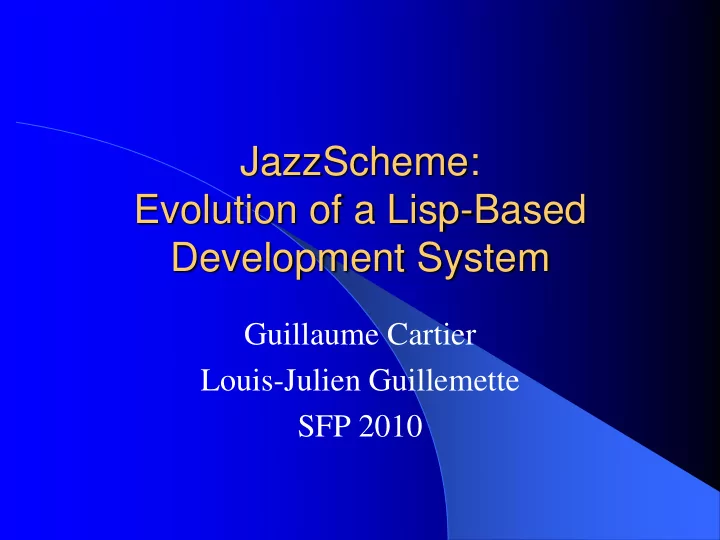

JazzScheme: Evolution of a Lisp-Based Development System Guillaume Cartier Louis-Julien Guillemette SFP 2010
Outline What is JazzScheme? Why JazzScheme? Some applications History – Port from C++ to Gambit Jedi IDE Future work
Why JazzScheme? Good question!
Roots Little Lisper Lisp machines – Complete programming environment Common Lisp – Macintosh Common Lisp Scheme Prisme (1990) (screenshots) – Highly graphical applications for real-life clients – Full access to the source code of the system
What is JazzScheme? Development system based on Scheme and Gambit Module system Hygienic macros Object-oriented programming Optional typing Cross-platform UI based on Cairo Binaries for Mac OS X, Windows and Linux Lisp-based IDE
Why (contd.) Build commercial software in Lisp Promote Lisp – Not by trying to convince people of its advantages – By creating a Lisp-based development system to write complex applications that would have been extremely difficult to develop using main stream languages (time, cost, feasibility, …)
Requirements Year 1998 Large-scale enterprise development support Open-source Built entirely in its own language
Built entirely in Lisp Rapid development cycle – High-level language and tools – Only one language to learn and master – Fast evolution Live by your word – New features & optimisations – Constant testing – Tribute to Lisp Openness to the community
Some applications MetaModeler – Database modeling Scheduler (screenshot) – Automated rule-based scheduler for hospitals Uranos – Enterprise Resource Planning (ERP) Jedi – Lisp-based IDE all written in Jazz
Birth of “classic” Jazz Year 1998 C++-based
Birth of JazzScheme Year 2006 Meeting Marc Feeley Jazz becomes open-source JazzScheme Scheme-based – (Chicken, PLT, Bigloo but not Gambit!) Port to Gambit
Why Gambit? Lightweight, high-quality Scheme implementation Conformance (R5RS and IEEE Scheme standards) Portability Performance Reliability Debugging Rich API – C foreign-function interface – Lightweight thread system that can support millions of concurrent threads – Networking – Unicode support
Port to Gambit Scheme was just too great! – Jazz becomes a radically different language We ended up having to – Port the language from C++ to Gambit – Port the libraries to the new incompatible language – Port the UI code from Windows to X11 and Mac OS X Lisp’s syntax saves the day Port – 200,000 lines of C++ – 15,000 lines of Scheme
Optimisations First working version – 95x slower than C++-based Jazz Statprof – Statistical profiler used to identify all the hotspots The current version – Gambit-based kernel now faster than the old C++-based kernel
Class-of class-of – Edit definitions – Edit references %%class-of – Multi-scheme Jazz (Chicken, PLT, Bigloo) Back / forward navigation
The present Auphelia – Christian Perreault – QT vs Jazz – Enterprise Resource Planning (ERP) Team Continuous evolution of the JazzScheme platform Part-time collaborators – Marc Feeley – Alex Shinn
C4 Project Remote debugger – Backtrace – Inspect variable – Dynamic redefinition
Jedi Code walker – Compile time highlight of errors Snapshots – Uses the same debugger infrastructure as the Jazz, Gambit and SWANK debuggers Inspector – Full support for Gambit data types Profiler View explorer – F8 / Edit Action Handler on Start Profile
Future work Deterministic profiler Code coverage Console-based REPL Stepper Designer SWANK debugger
Resources Website: www.jazzscheme.org – Documentation – Tutorials – FAQ Discussion Group – groups.google.com/group/jazzscheme IRC on Freenode – #jazzscheme – #gambit
Thank you!
Jazz as a macro Usual language development approach – Write a compiler that generates to a target language – Write the runtime support (GC, memory management, ...) – Write an interpreter (optional) As a macro – Reuse of all the work invested in Gambit – Written in a high-level language – Only a code walker needs to be developed – No performance penalty
Text Find definitions & references Dynamic redefinition Incremental search Search & replace with IrRegex Syntax highlighting Clipboard ring Mouse copy Emacs
Recommend
More recommend